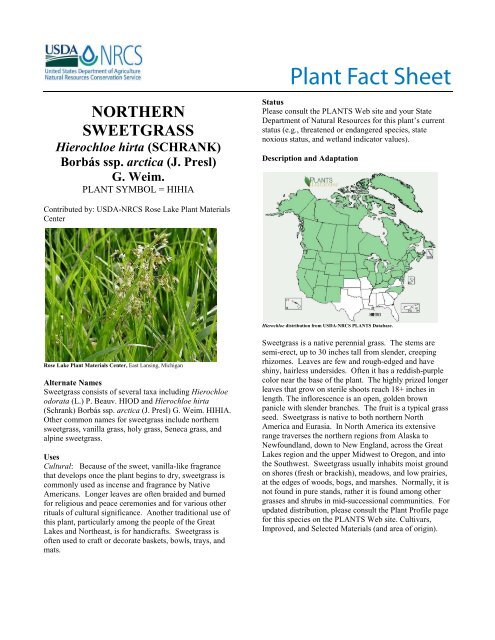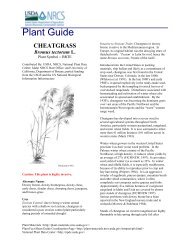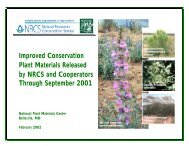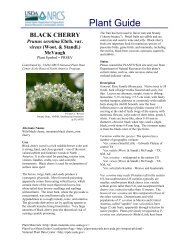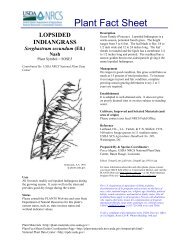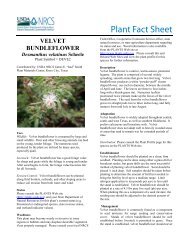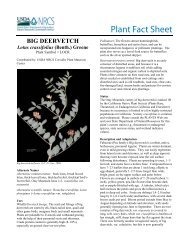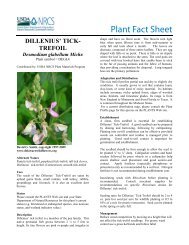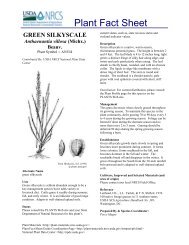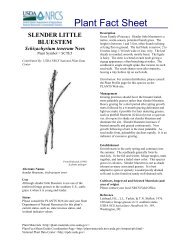Northern Sweetgrass (Hierochloe hirta) - USDA Plants Database
Northern Sweetgrass (Hierochloe hirta) - USDA Plants Database
Northern Sweetgrass (Hierochloe hirta) - USDA Plants Database
You also want an ePaper? Increase the reach of your titles
YUMPU automatically turns print PDFs into web optimized ePapers that Google loves.
NORTHERN<br />
SWEETGRASS<br />
<strong>Hierochloe</strong> <strong>hirta</strong> (SCHRANK)<br />
Borbás ssp. arctica (J. Presl)<br />
G. Weim.<br />
PLANT SYMBOL = HIHIA<br />
Contributed by: <strong>USDA</strong>-NRCS Rose Lake Plant Materials<br />
Center<br />
Rose Lake Plant Materials Center, East Lansing, Michigan<br />
Alternate Names<br />
<strong>Sweetgrass</strong> consists of several taxa including <strong>Hierochloe</strong><br />
odorata (L.) P. Beauv. HIOD and <strong>Hierochloe</strong> <strong>hirta</strong><br />
(Schrank) Borbás ssp. arctica (J. Presl) G. Weim. HIHIA.<br />
Other common names for sweetgrass include northern<br />
sweetgrass, vanilla grass, holy grass, Seneca grass, and<br />
alpine sweetgrass.<br />
Uses<br />
Cultural: Because of the sweet, vanilla-like fragrance<br />
that develops once the plant begins to dry, sweetgrass is<br />
commonly used as incense and fragrance by Native<br />
Americans. Longer leaves are often braided and burned<br />
for religious and peace ceremonies and for various other<br />
rituals of cultural significance. Another traditional use of<br />
this plant, particularly among the people of the Great<br />
Lakes and Northeast, is for handicrafts. <strong>Sweetgrass</strong> is<br />
often used to craft or decorate baskets, bowls, trays, and<br />
mats.<br />
Plant Fact Sheet<br />
Status<br />
Please consult the PLANTS Web site and your State<br />
Department of Natural Resources for this plant’s current<br />
status (e.g., threatened or endangered species, state<br />
noxious status, and wetland indicator values).<br />
Description and Adaptation<br />
<strong>Hierochloe</strong> distribution from <strong>USDA</strong>-NRCS PLANTS <strong>Database</strong>.<br />
<strong>Sweetgrass</strong> is a native perennial grass. The stems are<br />
semi-erect, up to 30 inches tall from slender, creeping<br />
rhizomes. Leaves are few and rough-edged and have<br />
shiny, hairless undersides. Often it has a reddish-purple<br />
color near the base of the plant. The highly prized longer<br />
leaves that grow on sterile shoots reach 18+ inches in<br />
length. The inflorescence is an open, golden brown<br />
panicle with slender branches. The fruit is a typical grass<br />
seed. <strong>Sweetgrass</strong> is native to both northern North<br />
America and Eurasia. In North America its extensive<br />
range traverses the northern regions from Alaska to<br />
Newfoundland, down to New England, across the Great<br />
Lakes region and the upper Midwest to Oregon, and into<br />
the Southwest. <strong>Sweetgrass</strong> usually inhabits moist ground<br />
on shores (fresh or brackish), meadows, and low prairies,<br />
at the edges of woods, bogs, and marshes. Normally, it is<br />
not found in pure stands, rather it is found among other<br />
grasses and shrubs in mid-successional communities. For<br />
updated distribution, please consult the Plant Profile page<br />
for this species on the PLANTS Web site. Cultivars,<br />
Improved, and Selected Materials (and area of origin).
Establishment<br />
<strong>Sweetgrass</strong> spreads vigorously by often-deep, creeping<br />
rhizomes. In the spring these rhizomes produce<br />
inconspicuous fruiting stems with sparse, short leaves.<br />
Longer leaves develop later from separate sterile basal<br />
shoots. Although sweetgrass can reproduce by seed, it is<br />
mostly infertile, producing few seedheads that contain<br />
few seeds. <strong>Sweetgrass</strong> is extremely cold hardy. It will go<br />
dormant in cold weather and resprout once ground<br />
temperatures reach 40oF. In the Great Lakes,<br />
Northeastern, and Midwestern regions flowering begins in<br />
the spring.<br />
<strong>Sweetgrass</strong> development from seed is very slow. This<br />
coupled with the infertile nature of the plant explains why<br />
plant division is the most successful method of<br />
reproducing sweetgrass. Plant division is accomplished<br />
by separating the individual propagules that have<br />
developed from the rhizomes of a spreading plant. Each<br />
propagule can then be placed in a container for further<br />
separation or future planting. Newly separated plants<br />
will do best if placed in the shade for 2–3 weeks while<br />
their roots establish. Then they may be transplanted at 1foot<br />
spacings into areas of partial shade to full sun.<br />
Management<br />
As sweetgrass is not drought tolerant, soil should be kept<br />
moist but not saturated. Fertilizer should be applied as<br />
appropriate for cool season grasses according to soil test<br />
recommendations.<br />
Rose Lake PlantMaterials Center, East Lansing, Michigan<br />
Longer leaves of the sterile shoots may be harvested<br />
several times during the year; however, the mid-season<br />
growth is considered superior. These leaves may be<br />
gathered by grasping the shoots firmly near the ground<br />
and pulling until they break from the rootstock an inch or<br />
two below the surface of the soil.<br />
Care should be exercised so roots are not pulled and<br />
plants are not damaged.<br />
Cultivars, Improved, and Selected Materials (and area<br />
of origin)<br />
<strong>Sweetgrass</strong> is available from commercial sources.<br />
Horticultural selections or local and regional ecotypes are<br />
marketed by nurseries. Contact your local Natural<br />
Resources Conservation Service (formerly Soil<br />
Conservation Service) office for more information.<br />
Prepared By<br />
John W. Leif, <strong>USDA</strong>-NRCS, East Lansing, MI<br />
Citation<br />
Leif, J. 2010. Plant fact sheet for sweetgrass [<strong>Hierochloe</strong><br />
<strong>hirta</strong> (Schrank) Borbás ssp. arctica (J. Presl) G. Weim.<br />
<strong>USDA</strong>-Natural Resources Conservation Service, Rose<br />
Lake Plant Materials Center, East Lansing, MI 48823.<br />
Published September, 2010<br />
Edited:13Apr2010jwl<br />
For more information about this and other plants, please<br />
contact your local NRCS field office or Conservation<br />
District , and visit the<br />
PLANTS Web site or the Plant<br />
Materials Program Web site <br />
<strong>USDA</strong> IS AN EQUAL OPPORTUNITY PROVIDER AND EMPLOYER


